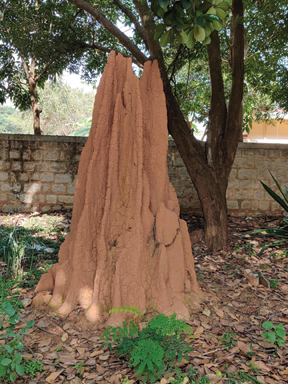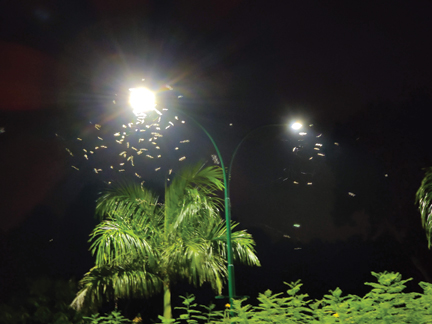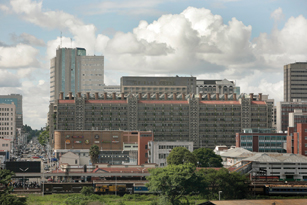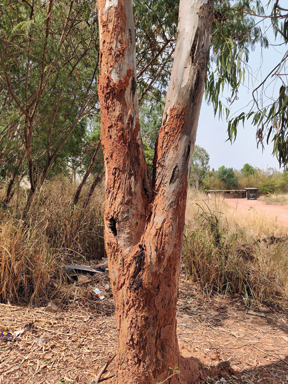Sanjay P. Sane
Some primal termite knocked on wood
And tasted it, and found it good!
And that is why your Cousin May
Fell through the parlor floor today.
– Ogden Nash (A termite)

This delightful poem captures the popular impression that most of us have of termites. They are usually viewed as undesirable pests whose main purpose is to invade and destroy homes, documents, precious old pictures, giant trees and so on. Perhaps some of this reputation is deserved, even if inadvertent. For termites have indeed acted as entropic agents by consuming many important chapters of human history, sometimes in very short time frames. Many a trained entomologist will find employment in the thriving pest control industry as an exterminator of termites. All of us have seen the tell-tale signs of termite ‘infestation’ – extraordinary mud tunnels that creep along our walls, or tall mounds in our backyards, but it is less common to actually see the tiny architects of these mud structures, for they remain hidden. As students of the natural world, we are forced to ask the question: who are these enigmatic insects? What function do they serve in our natural habitat? Is their reputation as ‘pest’ well-deserved? In this article, we will get to know termites a little better and maybe find more appreciation for these wondrous insects.
It should surprise many to learn that termites are social cockroaches. They belong to the Order Blattodea – same as cockroaches – and are close cousins of the wood-eating cockroaches Cryptocercus, as confirmed by recent phylogenetic and systematic studies. What distinguishes termites from cockroaches, however, is their social structure. Termites are considered by scientists to be eusocial, which means that their social structure is highly organized. They breed cooperatively and communally care for their offspring. Within a colony, multiple generations overlap. There is division of labour and a clear distinction between reproductive and non-reproductive groups. Similar social organizations are seen in diverse insects such as honeybees, ants, wasps, etc., all of which belong to the Order Hymenoptera, which is not related to termites. In fact, termites are commonly (and confusingly) referred to as “white ants”, which reflects how, in popular perception, their society resembles those of ants. Thus, termites offer among the rare examples of a non-Hymentopteran insect type that has independently evolved eusociality.

There are more than 3000 species of termites, both extinct and extant. They occur on all continents, except Antarctica. Almost all groups consume dead plant matter and leaf detritus. If you think back at your last trip in the woods and if you happened to take a peek into the cross-section of a trunk of a fallen tree, chances are that you saw it in some partial state of degradation thanks to termite activity. Millions of termites eat and digest the cellulose in trees. A dead tree is an invitation to termites to break the wood down into sawdust. Because we build houses out of dead tree material, termites inadvertently invade our homes to perform the same function for which they are so well-adapted.
Discussing the vast diversity of termites is a daunting task, so let’s focus on Odontotermes obesus, a termite species with which we may be most familiar. Across peninsular India, it is common to see termite mounds spring up in both rural and urban habitats. Because snakes may often inhabit the abandoned mounds, these mounds have attained a religious significance, which often guarantees their conservation. These impressive mounds are built by a specific species of mound-building termites. If you observe carefully, however, the mounds greatly vary in shape, size, texture and soil type. For example, the mounds built by the termite Odontotermes obesus can attain impressive heights of up to a few meters. The mounds of Macrotermes bellicosus in Africa are even taller ranging up to 5 meters, as also the enigmatic magnetic mounds of Amitermes meridionalis in Northern Australia. You will be impressed to know that these mounds are often as deep as they are tall. Inside the mounds, there are intricate passageways and chambers that house the entire colony. Many scientists have argued that we may regard these mounds (also beehives, anthills, etc.) and the colony housed within it, as a ‘superorganism’. Indeed, the physical structure of the mound is thought to serve the physiological function of improving gas exchange, regulating internal temperature of the mound and so on. If so, the structure of the mound offers an inspiration for architects, who hope to control the internal environments of their buildings using minimal energy. The Eastgate shopping mall in Harare, Zimbabwe is one such building which was inspired by termite mounds. Many have speculated that the great architect Antonio Gaudi modelled his masterpiece “La Sagrada Familia” to look like termite mounds.

Photo: David Brazier, courtesy: www.commons.wikimedia.org
How does this termite mound come about? It all begins with nuptial flights of termites immediately after a bout of rains. I am sure that you have experienced the spectacle of thousands of termites flying about, especially near lights. These are the so-called alate (i.e., wing bearing) termites. Males and females fly about and find each other and mate. Shortly after mating, they drop to the ground and shed their wings, as the main purpose of their nuptial flight is now complete. On the days after such nuptial flights, we see their wings lying all over the ground. These are the shed wings, although in many cases, they may also be the leftovers of a hearty termite meal by birds, bats and many other creatures. Nuptial flights are a food bonanza for many animals. The mated female and male find a site where they burrow and then begin to build a vast army of termites by laying copious numbers of eggs. These termites are mostly infertile and divided into major and minor workers and soldiers. This is the army that builds the mound inside which the mated female – now the queen of the colony – resides in a chamber. Only her abdomen swells to a massive size while the head and legs seem mostly defunct at this point. She cannot move unless she is carried on the backs of other termites. Not much is known about how the sessile queen controls the mound, but it is quite likely that she exercises some chemical control over the behaviours of her nest mates. There are any number of fascinating questions that remain unanswered about the inner lives of termites.

Photo: C messier, courtesy: www.commons.wikimedia.org
Odontotermes obesus mounds are mostly sealed. They keep the elements and the enemies out. If there is a breach in the mound, it is quickly repaired. If an army of ants manages to enter the breach before it is repaired, they are met with fearsome soldiers who try to keep them at bay. Curiously, the major and minor workers, as well as the soldier termites possess no eyes. Within their hermetically sealed mounds, eyes would not be of much use either as it is pitch dark. They move about using tactile cues that they get from their antennae. Antennae also are their main chemosensory or olfactory organs. This makes their task of building these massive mounds even more impressive because they have no blueprints and they have no eyes. We speculate that termite behaviour is almost algorithmic; specific cues help tell them where to excavate and where to deposit the mud that they use to build the mounds.
Not all termites within the mound lack eyes however. The mounds house several alate termites in special chambers. The alate termites have both eyes and wings. Immediately after the rains, the soldier and worker termites come out and open these chambers to allow the alate termites to fly out and mate. This brings us back one full circle in their life cycle.

Many mound-building termites, including Odontotermes obesus, have a special trick to digest the notoriously indigestible cellulose. They take help of specialized mutualistic microbes within their gut which are able to break down cellulose. Moreover, inside their mounds in special chambers, many mound-building termites farm a special type of fungus called Termitomyces, which is thought to help them digest the wood. Termites in turn eat the fungus. Maintaining the fungal culture within the mound requires high levels of internal humidity, which termites are known to maintain even under the driest ambient conditions. This means that termites can source water from somewhere deep within the ground, or else that the presence of their mound may indicate the existence of underneath water sources. This has not escaped the notice of our ancestors. Consider the following two verses:

If there is an anthill (i.e., a termite mound) near a jambu (Syzigium cumini) tree towards its east, there will be good water at a distance of two purushas (~ length of a person’s body) from there. (Surapala’s Vrikshayurveda, verse 304, 10th century CE)

If a taala (Borassus flabellifer) or naalikeri (coconut) tree is surrounded by anthills (again, termite mounds), there will be an aquifer towards the west, at a distance of four purushas and six hastas (one hasta = the length of one hand (from the elbow to the tip of the middle finger). (Upavanavinoda, verse 114, 13th century CE, Author: Sarngadhara)
These ancient verses draw an association between termite mounds and water sources. How they do this remains an enduring question.
I have discussed above just one species of termites. Each species has a peculiar natural history and very little is known about them in large part because their lives are usually lived within mud-covered tunnels and inside mounds. If you try to put a camera inside a mound to film the internal activity, it is quickly covered up by mud. Termites guard their secrets. Their nest types are equally diverse and each species has a different story to tell.
Let us now ask if termites indeed deserve their reputation as ‘pests’. Although we see termites and their destructive potential purely through a human lens, termites have been around for a lot longer than humans or even mammals. Scientists have debated about when the first termites evolved, with estimates ranging from 100 to 250 million years ago. Thus, from the perspective of the termites, humans or hominids have arrived on earth rather recently, even though their claim to earth is rather aggressive. Counter to their reputation as ‘pests’, termites are in fact an essential component of the ‘cycle of life’ in our forests. Without termites, trees would take much longer to degrade and leaf detritus on the forest floor would quickly pile up and the forests would look very different indeed. Termites have evolved a long and mutual relationship with other earthlings that surround them. Their mounds may be impressive structures, but once abandoned, they quickly go back to dust leaving space for other growth. Maybe the human antipathy towards termites reflects some of our own flaws: our desire to build immortal structures and documents, our exclusion of the natural world from habitats that we claim as ‘ours’.
Activity
- On the wall of a termite mound, make a small hole about the size of a bottle cap. This will need a sharp implement as the mound walls can be tough. Observe as the termites repair this hole.
- Same as above, except at the site of the hole, insert an empty bottle such that the hole is sealed with the open end of the bottle and the inside of the bottle is contiguous with the inside of the mound. Observe as termites deposit mud within the bottle.
The author is a professor at the National Centre for Biological Sciences – Tata Institute of Fundamental Research. He can be reached at sane@ncbs.res.in.
